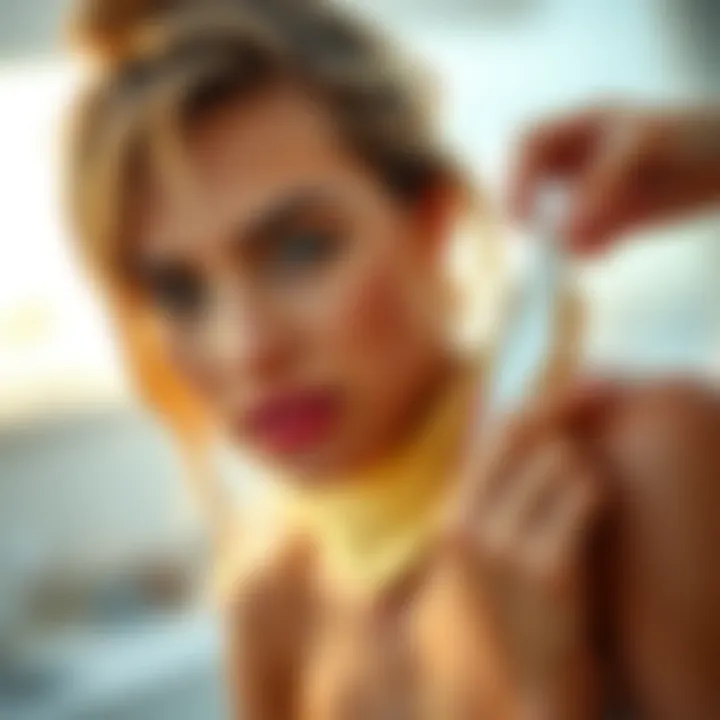Mastering the Art of Sunless Tanning Lotion Application


Intro
Understanding the intricacies of applying sunless tanning lotion goes beyond just slapping on some cream and hoping for the best. Getting an even tan without streaks or blotches requires a combination of preparation, technique, and care. In this guide, we'll discover how to achieve that radiant glow safely, avoiding the harsh effects of sun exposure, while also addressing any common hiccups that may arise in the process.
With the growing awareness of skin health, more people are turning to sunless tanning options as a way to obtain a bronzed complexion without the dangers of UV rays. For women of all ages, this offers a fantastic alternative, allowing one to feel confident and beautiful in their own skin.
We will explore various aspects of sunless tanning, from the key trends shaping the beauty landscape today, to practical tips and sustainable practices to keep in mind. Whether you're a seasoned pro or a newcomer to the world of tanning lotions, this comprehensive guide aims to provide crucial insights and actionable steps to elevate your tanning game.
As we embark on this journey, let's delve into the key trends influencing the contemporary beauty scene.
Understanding Sunless Tanning
Sunless tanning has carved out a significant niche in the beauty and skincare industry, garnering attention for those seeking a radiant and sun-kissed glow without the harmful effects of UV exposure. The importance of grasping the concept of sunless tanning lies not just in achieving the desired look, but also in understanding the various benefits and considerations that accompany its use. By choosing sunless tanning products, one can enjoy a safer alternative that circumvents the risks linked to traditional tanning methods, such as skin damage and premature aging.
What is Sunless Tanning?
So, what exactly is sunless tanning? In simple terms, it refers to the use of various products that allow individuals to achieve a tan without direct sunlight. This method promotes an appealing skin glow through the application of specially formulated lotions, sprays, foams, and gels packed with ingredients like DHA (dihydroxyacetone), which react with the skin's outer dead cells, resulting in a temporary pigmentation change. The beauty of this approach is its versatility; anyone can indulge in a sun-soaked aesthetic regardless of their skin type or the season, making it an attractive option for all.
Types of Sunless Tanning Products
The world of sunless tanning encompasses multiple product forms, each designed to cater to different needs and preferences. Understanding the nuances of these options can help individuals find the perfect match. Here are some of the main types of sunless tanning products:
Lotions
Lotions represent one of the classic forms of sunless tanning products. They typically have a creamy consistency, allowing for easy application that covers the skin smoothly. A key characteristic of lotions is their ability to offer a gradual tanning effect, providing users with control over the depth of tan achieved. This makes them particularly beneficial for first-timers or those who prefer a subtle glow.
However, it's essential to note that lotions can sometimes take longer to dry, which might lead to uneven results if not applied carefully. Yet, with a diligent approach, they can yield beautiful, natural-looking results that can be built up over time.
Foams
Foams are another popular choice among sunless tanning enthusiasts. Their light, airy texture sets them apart, making them incredibly easy to spread across the skin. A standout feature of foams is their quick-drying formula, allowing users to get dressed almost immediately after application without worrying about smudging.
However, it’s worth mentioning that because foams often dry rapidly, they require a more precise application to ensure even coverage. For those looking for a quick tan without lengthy waiting periods, foams present an excellent solution.
Gels
Gels have been gaining traction in the sunless tanning arena due to their lightweight formula and quick absorption. They tend to glide on effortlessly, providing a refreshing feel upon application. A key characteristic of gels is their ability to hydrate the skin while imparting color, combining skin care benefits with bronzing.
Despite their advantages, some users might find gels less forgiving when it comes to even distribution, especially if applied hastily. Still, their dual-purpose nature can be particularly appealing to those who prioritize skin health along with a bronzed complexion.
Sprays
Sprays are celebrated for their ease of use and efficiency. They deliver a fine mist that can envelop the skin quickly, making for a seamless application process. One of the main advantages of sprays is their ability to reach difficult areas that lotions or foams may not cover as effectively.
However, they can present challenges in terms of controlling the amount applied, leading to potential splotches if not executed cautiously. Those who are experienced in sunless tanning often gravitate toward sprays for their convenience and speed which, with some practice, can lead to stunning results.
Sunless tanning products offer numerous benefits, including reduced risk of skin damage and customizable results, appealing to a broad audience who seeks that golden glow without the sun's harsh rays.
Understanding the different types of sunless tanning products can empower individuals to make informed choices that suit their skin type, lifestyle, and comfort level. Whether opting for lotions, foams, gels, or sprays, knowing how each formulation works equips users with the tools to achieve their desired look effectively.
Preparation for Application
Preparation is the unsung hero of achieving a flawless sunless tan. It sets the stage for a seamless application and ensures that the tan develops evenly, leading to a natural-looking finish. Skipping these crucial steps can result in a patchy tan that looks more like a misadventure than a sun-soaked glow. Therefore, dedicating time to proper skin preparation not only enhances the tanning process but also prolongs the life of the tan.
Skin Exfoliation and Preparation


Choosing the Right Exfoliant
Selecting an effective exfoliant is pivotal in your tanning journey. This process sloughs off dead skin cells, revealing fresh skin beneath. Physical exfoliants, such as scrubs, use granules to physically remove those dead cells, while chemical exfoliants, like acids, dissolve them without scrubbing. It's wise to lean towards gentle products that won't irritate your skin, as sensitive complexions can react negatively to harsh scrubs.
Unique to choosing the right exfoliant is its ability to cater to specific skin types—oily skin may benefit from salicylic acid, while drier skin might prosper from lactic acid. The right match not only enhances the effectiveness of sunless tanning but can also improve overall skin texture. However, over-exfoliation can lead to sensitivity and peeling, thus it's important to strike a balance.
Exfoliating Techniques
Once the right exfoliant is in hand, the next step is mastering the technique. Circular motions while applying a physical scrub can help ensure even coverage, while for a chemical exfoliant, a gentle swipe with a cotton pad will suffice. Taking time to exfoliate properly—approximately 5 to 10 minutes real care to this step—is essential for even application.
They say the devil is in the details, and the same holds for exfoliating. Pay attention to rough areas such as elbows, knees, and ankles, as these spots tend to absorb more product, leading to darker patches. In the end, effective exfoliation primes the skin and improves the bond with tanning lotions, greatly contributing to desired results.
Moisturizing the Skin
Targeting Dry Areas
With exfoliation done, it’s time to moisturize, particularly focusing on dry areas. Targeted hydration plays a key role in ensuring those normally parched patches—like the aforementioned knees, elbows, and even feet—don’t absorb an excessive amount of tanning product. Applying a layer of moisturizer here reduces the risk of excessive or uneven darkening in these areas.
The downside of neglecting this step is a splotchy tan that draws the eye for all the wrong reasons. A light, oil-free moisturizer works well for most skin types, while those with drier skin may opt for a heavier cream. Just remember not to go overboard, as using too much lotion can create a barrier that hinders the tanning product's absorption.
Timing Your Hydration
Timing is crucial when it comes to hydration. Ideally, applying moisturizer at least one hour before using the tanning lotion is necessary. This not only allows the skin to absorb the moisture but also gives it time to settle down, ensuring no greasy feel before you apply the tanner.
In this context, it’s all about preparation, much like the calm before a storm. Patience allows the skin to be in tip-top shape, ready to greet the tanning lotion with open arms. Once hydrated, the skin will absorb the tanning lotion in a manner that promotes even development, ultimately maximizing the glow.
Remember: Proper preparation sets the stage for a sunless tan that won’t leave you feeling like a spotted leopard.
By understanding and executing these preparation steps, readers can guarantee a more successful tanning experience, resulting in a uniform and enviable glow.
Application Techniques
Successfully applying sunless tanning lotion is no small feat, and this is where application techniques come into play. Using the right methods can make all the difference in achieving that golden glow you're after. The importance of these techniques lies in their potential to ensure a smooth and even application, allowing for a more natural and lasting tan. It's not just about slapping on some lotion and hoping for the best; the specifics matter significantly.
Choosing the Right Environment
Lighting Considerations
Good lighting is key when you're dealing with sunless tanning. Whether you're applying indoors or outdoors, the quality and direction of light can greatly affect your application. Bright, natural light helps you see any spots you might miss and allows you to have a better view of how things are turning out.
Despite the temptation to apply in dim light (where flaws might seem hidden), it can backfire and lead to uneven results. So, opting for a well-lit area ensures you're not navigating blind. If you are inside, a bathroom with ample lighting or even a space with a big window can do wonders. Sometimes, investing in a good light bulb can also make a world of difference.
"Good light is like a good friend; it shows you all that you need to see!"
Surface Choices
The surface on which you apply your tanning product is another crucial factor to consider. Areas that can easily be cleaned and are free from distractions are always recommended. A bathroom or a designated area with tile or linoleum flooring is perfect. These materials tend to be easier to wipe down if there are any spills or drips.
You might think about applying on carpet but that could become a bit of a hassle. Why risk that lovely bottle of self-tanner staining your favorite rug? Moreover, some surfaces are better for standing (like tile) because they dry quickly and make it easier to see your legs and feet as you apply. Think ahead to avoid any slip-ups here.
Applying the Tanning Lotion
Best Practices for Even Coverage
Achieving an even coverage is the golden rule of sunless tanning, and it’s an art more than a science. Start with small amounts of lotion and build up gradually—less is often more here. Apply in circular motions to eliminate streaks and ensure uniform distribution. This technique isn't just a suggestion; it's a necessity.
Using your palm can sometimes lead to coloring it and thus ending up looking like a raccoon. Instead, consider using a gloved hand or applicator mitt which can make the job easier and cleaner. And don't forget to adjust how much lotion you're putting on for areas that tend to absorb it differently, like elbows and knees.


Using Application Tools
The right tools can elevate your tanning game from average to spectacular. Application mitts, for instance, are favored by many because they allow for seamless blending and protect your hands from staining. Additionally, these tools often come with a texture that helps in spreading the lotion evenly.
On the flip side, if you find yourself without an applicator, using your hands could work, but be diligent about washing them immediately after to avoid any strange hand markings. Also, some prefer spray bottles for a lighter application, however, this requires some practice to avoid hot spots.
Common Pitfalls in Application
Over-applying
The term "less is more" rings particularly true with sunless tanning. Many individuals make the mistake of thinking that more product leads to a deeper tan. In reality, over-applying can result in a muddy or orange tinge. Instead, use a light hand; it’s easier to add more lotion than it is to correct overzealous applications.
It's also worth noting that the formula can interact differently with each skin type. For instance, drier skin may absorb more product and could result in patches. Thus, always remember moderation is key.
Neglecting Areas
One of the most common errors is neglecting zones that are often overlooked, like behind the ears or in between your toes. These areas can easily become starkly different in tone than the rest of your body. To avoid this, take a mental note or do a final check before wrapping up. Ensuring full coverage boosts your overall tan experience. By giving attention to these details, you can sidestep the embarrassment of discrepancies.
Ultimately, mastering application techniques requires patience and practice, but the outcome can be rewarding. With the right environment, practices, and awareness of common pitfalls, you can achieve that enviable sun-kissed look without spending hours under the blazing sun.
Post-Application Care
After applying sunless tanning products, the journey doesn’t stop at simply achieving a bronze hue. Post-application care is crucial for maintaining an even tan and ensuring that your skin remains healthy and vibrant. This phase involves making sure you allow the tan to set properly and taking steps to nourish your skin afterward. Neglecting this stage can lead to uneven fading or even skin irritation, turning your glowing effort into a less-than-friendly experience.
Setting the Tan
Drying Times
One important element of setting the tan is understanding drying times. Drying time refers to how long it takes for the tanning lotion to fully absorb into the skin before you can engage in other activities, like dressing or exercising. Generally speaking, it’s best practice to allow about 10 to 15 minutes for the product to dry and develop properly. The key characteristic of this waiting period is its pivotal role in ensuring that the tan sets accurately, leading to a more natural appearance.
If you skimp on the drying time, you risk smudging or transferring the product onto your clothes, which can mess up your tan. This is not just a minor inconvenience; it can lead to streaks that stick out like a sore thumb. A unique feature of drying times is how they vary based on product formulation. For instance, some gels may dry quicker than lotions, making them a popular choice for those who are on-the-go. On the downside, ambient humidity may prolong drying time, so it's wise to take that into account when planning your application.
Clothing Choices After Application
Another crucial aspect of post-application care is your clothing choices right after applying the tanning lotion. Opting for loose, dark-colored clothing is often advisable. The key here is to minimize contact with your skin while allowing some airflow, which can help in the even development of your tan. Tight clothing can restrict this process and lead to patchy outcomes, while lighter colors may pick up product residue, leaving marks.
The unique feature of this guideline is its dual purpose: it not only protects your freshly applied tan but also helps maintain skin health overall. Fabrics that breathe can be more comfortable, especially after applying lotions that can initially feel sticky. However, you should avoid wearing anything with rough textures and elastic bands, as these can cause indents and uneven patches.
Maintaining the Tan
Moisturization Strategies
Moisturization strategies play a fundamental role in keeping your tan looking fresh and radiant. Regular moisturizing replenishes the skin’s moisture barrier, which is essential for reducing the chances of the tan fading unevenly. A well-hydrated skin tends to retain color more effectively and provides a more consistent appearance.
The key advantage here is that not all moisturizers are created equal. Products containing ingredients like aloe vera or hyaluronic acid can provide a significant boost to hydration. This type of upkeep is crucial, especially as some self-tanners have drying agents that can strip moisture from your skin. On the flip side, using heavy oils or creams immediately could interfere with the tan's color and placement.
Avoiding Common Mistakes
Lastly, understanding how to avoid common mistakes is an essential strategy for maintaining your tan. Many people underestimate the importance of regularly exfoliating before reapplying; failing to do so can lead to uneven fading. It's also critical to avoid products containing alpha-hydroxy acids or harsh scrubs, as these can strip away your tan more rapidly than expected.
Another common pitfall is not adjusting your bathing routine. Frequent showers and swimming can dehydrate the tan, leading to quicker fading. Instead, gentle washing with mild soaps helps maintain the color while ensuring your skin feels soft. Identifying these mistakes allows you to proactively manage your tan while enjoying the results of your sunless tanning efforts.
Troubleshooting Common Issues
Sunless tanning can be a great way to achieve that sun-kissed glow without the dangers of UV exposure. However, it’s not always smooth sailing. Understanding common issues can make the difference between a flawless tan and a less-than-desirable result. Tanning mishaps can happen to anyone, and knowing how to troubleshoot these problems can elevate your tanning experience significantly. Whether we're talking streaks or spots, every issue comes with its own nuances that are essential for achieving that radiant look.


Dealing with Streaks
Streaks can be a tanning nightmare, contrasting sharply with the desired smooth gradient across your skin. These lines can appear due to various factors, such as uneven application or improper skin prep. The importance of handling this issue lies in correcting and preventing streaks to maintain a polished, even tone.
Prevention Techniques
Prevention techniques are akin to laying a strong foundation before building a house; it’s all about getting things right from the start. A key characteristic of this approach centers around thorough skin preparation. Whether it’s in the form of exfoliation or applying a light moisturizer, preparing your skin minimizes the risk of uneven patches when the tanning product is applied.
Moreover, using a tanning mitt can tremendously improve your application technique. The unique feature of using such a tool is its ability to distribute the product evenly while minimizing the chances of localized streaking. Some may view it as an extra step, but considering its advantages in achieving a more uniform tan, it is indeed worth it. On the other side, it requires a little investment, which may put some folks off.
Correction Methods
When prevention techniques fail, knowing how to address mistakes becomes crucial. Correction methods are essential for managing any unsightly streaks that did make it onto your freshly tanned skin. One approach involves using a gentle exfoliator to buff away the areas where streaking occurs, which can help smooth out the skin's surface. This process might feel like striking a match in a rainstorm—it’s not guaranteed, but it helps kickstart the correction.
Just like preventive measures, correction methods come with their own pros and cons. While they can help restore a more consistent finish, it’s also important to monitor your skin’s reaction, especially for sensitive types. Quick fixes are appealing but balancing efficacy and safety is of paramount significance.
Addressing Continued Development
Once you've applied your sunless tanning lotion, the development phase is where the magic unfolds. However, some might find themselves baffled by the results that appear—or fail to appear. Understanding how the product works and what you can expect during this time is essential to ensure satisfaction with your final result.
Understanding Development Time
Understanding development time is pivotal in managing your expectations post-application. Most sunless tanning lotions require a certain window to properly develop, often ranging from a few hours to overnight. The key characteristic of this concept is that the tan doesn’t show up instantly, and patience is often required.
A unique aspect here is that development can be influenced by skin type, the product utilized, and even the environmental conditions. This means that while one person may start to see results in a few hours, another might need to wait a bit longer. The advantage of this understanding is that it helps you avoid frustration and allows you to plan your day accordingly, be it for an event or casual outing. But, one must accept that it requires some time, which not everyone may find ideal.
Adjusting Expectations
After going through the tiring application and waiting for the tan to develop, some may end up unsatisfied with their results simply because they didn’t set realistic expectations. Adjusting expectations plays a significant role in how one perceives the effectiveness of their tanning efforts. Knowing what kind of results to anticipate can shape the overall experience.
The key characteristic of this step is focusing on the product claims versus individual preferences. Each sunless tanner promises different things—some may offer a light glow while others boast a deep bronze. Understanding your skin tone and choosing products correctly are advantageous because it reduces disappointment later on.
The unique factor in this adjustment process lies in the understanding that everyone's skin is unique. While results can vary widely, adapting your expectations accordingly is essential for a fulfilling tanning journey. This may mean accepting lighter results than those seen in ads but recognizing your own beauty—even in subtle shades—can cultivate more genuine satisfaction.
Ethical Considerations
In the world of self-tanning products, ethical considerations are more than just a passing trend; they resonate deeply within the choices we make. This section sheds light on the importance of examining the origins of tanning products, their environmental impact, and the ingredients they contain. Understanding these elements not only contributes to personal health but also champions broader sustainability goals.
Sustainability in Tanning Products
Sustainability in tanning products has emerged as an essential topic amid rising awareness about environmental issues. Consumers today are more than just buyers; they often want to know how the products they purchase impact the planet. Sunless tanning lotions can vary widely in terms of their sustainability profiles. Ingredients derived from renewable resources take precedence over those sourced from harmful extraction methods. Ideally, manufacturers would prioritize eco-friendly practices, minimizing waste and carbon footprints throughout production.
Sustainable formulations are often biodegradable, reduce plastic use, and avoid harmful chemicals. Using such products not only ensures you look good but feels good about contributing to a greener world. After all, sustainability is like a boomerang – what we toss out into the environment often comes back around in unexpected ways.
Ingredient Awareness
Ingredient awareness in sunless tanning lotions goes hand-in-hand with ethical considerations. When applying a product to your skin, knowledge about what’s inside becomes paramount. Not all ingredients are created equal. Some can cause irritation or even long-term health issues. Hence, being aware helps you steer clear of harmful substances while making informed choices.
Identifying Harmful Ingredients
When discussing harmful ingredients, it’s essential to identify what they are and where they originate. A common culprits include parabens, synthetic dyes, and certain alcohols. These can not only increase the risk of skin irritation but may also have broader implications as some are linked to hormonal disruptions. Being able to spot these harmful additives in product labels is crucial for any serious self-tanner. A smart consumer examines the label just like a hawk watches its prey. By becoming knowledgeable about specific components and their potential downsides, readers are empowered to choose products that are both safer and healthier. Adopting a discerning eye can lead to an overall improvement in one’s skin health and wellness journey.
Choosing Eco-Friendly Options
Choosing eco-friendly options signifies a commitment to both personal health and the environment. These products typically utilize natural ingredients, which are not only gentler on your skin but also kinder to the earth. They often exclude harsh chemicals, opting instead for plant-based ingredients that have moisturizing properties. It’s like choosing homemade over takeout; you know exactly what’s going into your body without unwanted surprises.
Brands investing in sustainable practices also demonstrate their commitment to responsible sourcing and production methods. This often results in minimal packaging or the use of recycled materials. The unique feature of eco-friendly tanning products is their dual focus: achieving a bronzed look while upholding ethical standards. However, they might come with a higher price tag, reflecting the quality and sustainability of the ingredients used.
In sum, understanding the ethical implications of sunless tanning products not only fosters better choices for oneself but also promotes a healthier coexistence with the planet. Knowledge is your best ally in this journey, making every application truly golden.
"Being responsible is about making conscious choices, even in the small aspects of our lives, like the beauty products we choose."
By integrating sustainability and ingredient awareness, you are not just tanning your skin; you are also advocating for a world that values health and responsible practices. For more on eco-friendly products, check out resources from Natural Products Association and Environmental Working Group.



